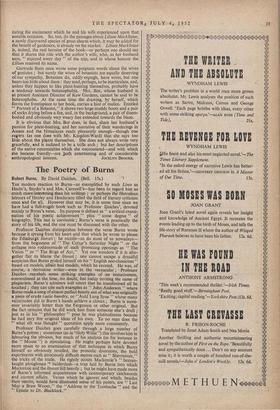Plant-Hunting
Plant Hunter in Manipur. By F. Kingdon-Ward. (Cape. 15s.) IN 1947 Mr. Kingdon-Ward was commissioned, by the New York Botanic Garden, to explore the mountainous regions of Manipur, that little-known province lying between Assam and Burma. His book is, as he, says in his preface, a plain tale of plant-hunting in the hills ; and one cannot help wishing that it were, in some respects, a little less plain. It is hard to guess, indeed, for precisely what type of reader the book was written. Considered merely as a travel-book, it is of only moderate interest, and as a record of Mr. Kingdon-Ward's botanical discoveries it must seem disappointing to the specialist. The author's attitude to his subject seems, in fact, rather irresolute ; one guesses that, he is afraid of being too " techni- cal," and, at the same time, of not being technical enough. Thus he will refer in passing to (for example) EngeMardtia spicata, assuming a knowledge which few readers will possess ; on the other hand, his descriptions of those plants of which he treats more fully are insufficiently detailed to produce any clear image in the reader's (and more especially in the botanist's) mind. Thus, when he is discussing the problems of plant taxonomy, with particular reference to the allied genera Lilian/ and Nomocharis, he fails to give any detailed account of what, in fact, is the distinction between the one genus and the other. A certain amount of more detailed matter is provided in an appendix ; but one feels that, since this material is so nearly related to the narrative, it might with advantage have been incorporated in the text: The book would, I think, have been better if its author had given himself a freer rein. The best parts of it are undoubtedly the descrip- tions of his more interesting " finds " ; his account, for example, of the discovery of Primula Sherriffiae really does succeed in communi- cating the excitement which he and his wife experienced upon that notable occasion. So, too, do the passages about Lilium Mackliniae, a newly discovered species of great charm which, it may be added for the benefit of gardeners, is already on the market. Lillian Mackliniae is, indeed, the real heroine of the book—or perhaps one should say that it shares this role with the author's wife, who, as her husband says, " enjoyed every day " of the trip, and in whose honour the Lilium received its name.
Gertrude Stein once wrote some poignant words about the wives of geniuses ; but surely the wives of botanists are equally deserving of our sympathy. Botanists do, oddly enough, have wives, but one hears too little about them : they tend, perhaps, to be inarticulate, and, unless they happen to like plant-hunting themselves, probably have a tendency towards botanophobia. Mrs. Bor, whose husband is at present Assistant Director of Kew Gardens, cannot be said to be botanophobe. At the same time the drawing, by herself, which forms the frontispiece to her book, carries a hint of malice. Entitled Portrait of a Botanist," it shows two large muddy boots and a pair of socks drying before a fire, and, in the background, a pair of disem- bodied and obviously very weary feet extended towards the blaze.
It is obvious that Mrs. Bor does, in fact, share her husband's passion for plant-hunting, and her narrative of their wanderings in Assam and the Himalayas reads pleasantly enough—though one regrets (as one does with Mr. Kingdon-Ward) that she says too little about the plants themselves. She does not always write very gracefully, and is inclined to be a trifle arch ; but her descriptions of the native communities which she encountered—and with which she became friendly—are .joth entertaining and of considerable
anthropological interest. JOCELYN BROOKE.



























































 Previous page
Previous page